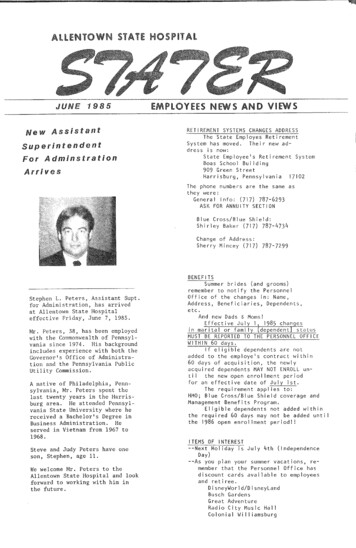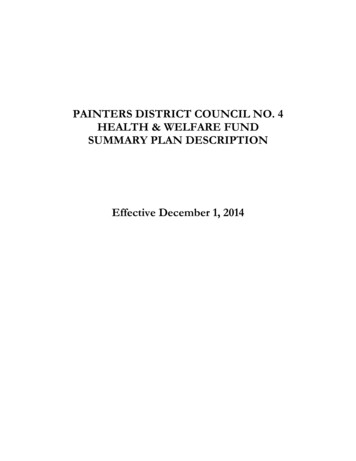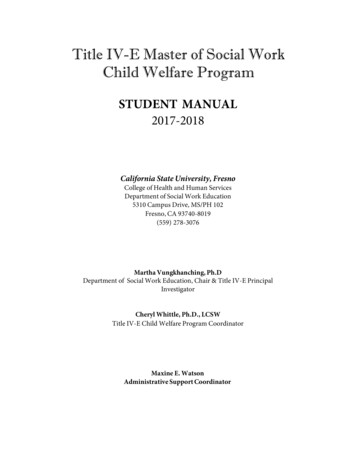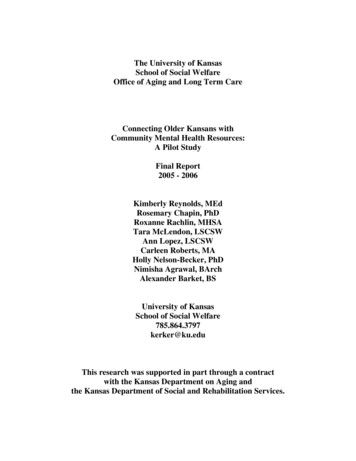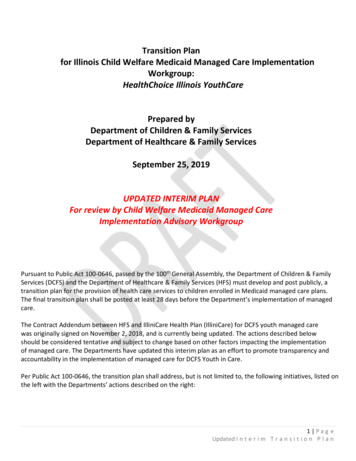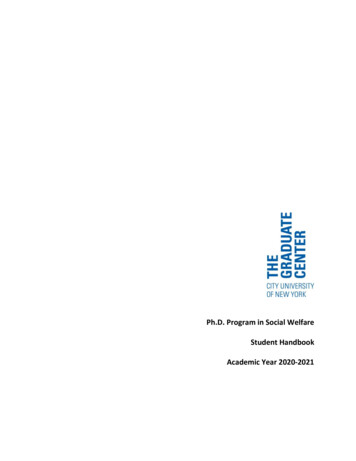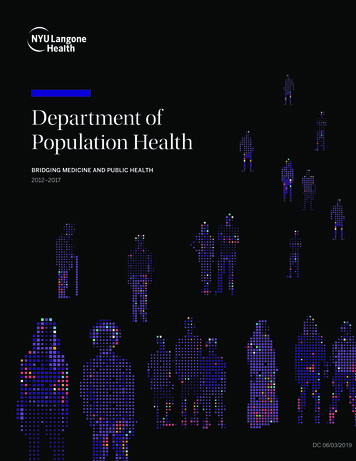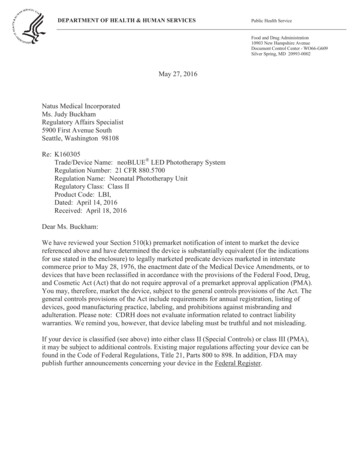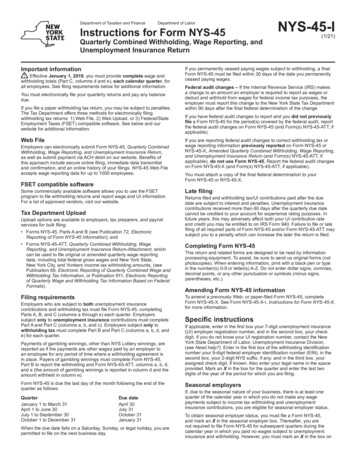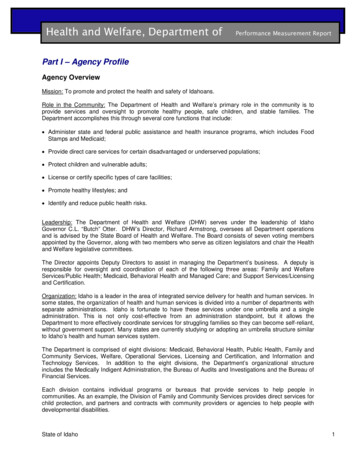
Transcription
Health and Welfare, Department ofPerformance Measurement ReportPart I – Agency ProfileAgency OverviewMission: To promote and protect the health and safety of Idahoans.Role in the Community: The Department of Health and Welfare’s primary role in the community is toprovide services and oversight to promote healthy people, safe children, and stable families. TheDepartment accomplishes this through several core functions that include: Administer state and federal public assistance and health insurance programs, which includes FoodStamps and Medicaid; Provide direct care services for certain disadvantaged or underserved populations; Protect children and vulnerable adults; License or certify specific types of care facilities; Promote healthy lifestyles; and Identify and reduce public health risks.Leadership: The Department of Health and Welfare (DHW) serves under the leadership of IdahoGovernor C.L. “Butch” Otter. DHW’s Director, Richard Armstrong, oversees all Department operationsand is advised by the State Board of Health and Welfare. The Board consists of seven voting membersappointed by the Governor, along with two members who serve as citizen legislators and chair the Healthand Welfare legislative committees.The Director appoints Deputy Directors to assist in managing the Department’s business. A deputy isresponsible for oversight and coordination of each of the following three areas: Family and WelfareServices/Public Health; Medicaid, Behavioral Health and Managed Care; and Support Services/Licensingand Certification.Organization: Idaho is a leader in the area of integrated service delivery for health and human services. Insome states, the organization of health and human services is divided into a number of departments withseparate administrations. Idaho is fortunate to have these services under one umbrella and a singleadministration. This is not only cost-effective from an administration standpoint, but it allows theDepartment to more effectively coordinate services for struggling families so they can become self-reliant,without government support. Many states are currently studying or adopting an umbrella structure similarto Idaho’s health and human services system.The Department is comprised of eight divisions: Medicaid, Behavioral Health, Public Health, Family andCommunity Services, Welfare, Operational Services, Licensing and Certification, and Information andTechnology Services. In addition to the eight divisions, the Department’s organizational structureincludes the Medically Indigent Administration, the Bureau of Audits and Investigations and the Bureau ofFinancial Services.Each division contains individual programs or bureaus that provide services to help people incommunities. As an example, the Division of Family and Community Services provides direct services forchild protection, and partners and contracts with community providers or agencies to help people withdevelopmental disabilities.State of Idaho1
Health and Welfare, Department ofPerformance Measurement ReportDHW has 23 field offices geographically located to reach each area of the state, three state institutions,and 2,847 authorized full-time employees in SFY14.DIVISIONSThe Department is organized in eight divisions. Each division contains programs and bureaus thatprovide an administrative structure for the delivery of services and accountability.Division of MedicaidA. OverviewThe Division of Medicaid provides comprehensive medical coverage for eligible Idahoans in accordancewith Titles XIX and XXI of the Social Security Act and state statute. The Division does not provide directmedical services, but contracts and pays for services through providers similar to private health insuranceplans. Medicaid provides services for low-income families, which includes children and pregnant women;the elderly; and people with disabilities.B. Highlights 2014 Legislative Update – Medicaid completed the implementation of all requested items in theintent language from Senate Bill 1190 which included:oDelivering a monthly report to the Legislative Services Office and the Division of FinancialManagement comparing monthly actual expenditures to the budget as appropriated.oReporting quarterly on the continued effects of House Bill 260 (Session Laws 2011, Chapter164).oProviding quarterly reports on progress toward integrating managed care approaches intothe state Medicaid system.Additionally, Medicaid received legislative support for the following changes:o Dental benefits were restored to Medicaid participants in the enhanced plan who had notbeen covered since the implementation of House Bill 260.oContinuing to plan and implement managed care tools and programs as directed by thelegislature. Specifically, ongoing support for managing outpatient behavioral health servicesvia a contract with Optum Idaho and expanded benefits available through Idaho’s managedcare option for Medicaid participants who are also eligible for Medicare.The Division also received budget authority for several ongoing initiatives; primary care networkdevelopment, Idaho Home Choice (Money Follows the Person), the Children’s HealthcareImprovement Collaboration, and the Electronic Health Record Incentive program. Budgetapproval was also received for a rate increase for community Personal Care Services that willassist in maintaining equity with reimbursement for similar services in facilities. Electronic Health Records – Idaho Medicaid successfully launched the Medicaid ElectronicHealth Record Incentive Program Stage 2 Meaningful Use on July 1, 2014. The program is theresult of the American Recovery and Reinvestment Act (ARRA) of 2009 which authorizedincentive payments for eligible Medicare and Medicaid providers who meaningfully use certifiedelectronic health record technology. During the second year of operations, Medicaid paid 27hospitals 13,847,069 and 499 eligible professionals 7,278,834 in federal incentivepayments. The incentive program will run through 2021 and is expected to provide millions ofdollars to Idaho hospitals and medical professionals during that time. Idaho Medicaid serves asthe pass-through for the incentive payments, which are federal dollars. Children’s System Redesign - The Department concluded the first full year of the new children’sbenefits on June 30, 2014. The data from this year gives the Department a more comprehensiveState of Idaho2
Health and Welfare, Department ofPerformance Measurement Reportpicture of service implementation, costs, and impacts. The current enrollment in all children’sdevelopmental disability benefits is in excess of 2500. The array of benefits replacing the oldservices of Developmental Therapy and Intensive Behavioral Intervention includes Respite,Habilitative Intervention, Habilitative Supports, Family Education, Family Training, Assessment,and Interdisciplinary Training. Habilitative Intervention was utilized by 42% of the participants,Habilitative Supports by 51%, 5% accessed Respite, with additional Assessments, FamilyEducation, Family Training, and Interdisciplinary Training being utilized at 1% each. While thereare still challenges, the program overall is operating well. The Department continues to workclosely with parents, advocates, and providers to ensure ongoing improvements in the operationof the program and ensure the best services possible for children with developmental delays inIdaho. Technology Performance – From July 2013 to June 2014, the Division of Medicaid has continuedto work closely with Molina Medicaid Solutions (claims processing and reporting), MagellanMedicaid Administration (pharmacy), Truven (data warehouse and decision support), andMedicaid providers to make system enhancements, improve service to all stakeholders, and meetthe Centers for Medicare and Medicaid Services (CMS) requirements. Approximately 119,000claims are processed through the Molina system weekly. Over 95% of claims are accepted bythe system and over 99% of approved claims are paid within 5-15 days. Total weekly payoutfrom Molina Medicaid systems average close to 29.3 million (this represents total paymentincluding Fee for Service claims and Managed Care fees). An average of 39,912 claims areprocessed weekly by Magellan. All Magellan claims are paid within 7 days, and the weeklypayout is approximately 2.8 million. Children’s Healthcare Improvement Collaboration (CHIC) – The state of Idaho, in partnership withthe state of Utah, received a five year Children’s Health Insurance Program Reauthorization Actquality demonstration grant for 10,277,360. This grant is in the fifth and final year. The projecthas been successful in all grant enteredmedicalhomes:Three pediatric patient centered medical home demonstration sites will be recognized byNational Committee for Quality Assurance and sustain those improvements by adding aMedical Home Coordinator to their organization.oImplementing evidence-based quality improvement strategies: 72 Pediatricians, 42 Familyphysicians, 11 Nurse Practitioners and 7 Physician Assistants have participated in at leastone of 6 learning collaboratives. Learning collaboratives help teach practices how to identify,track and change process that lead to better health outcomes for the children of ough this grant opportunity a sustainable improvement partnership opportunity wascreated. A 12 member, multi-disciplinary Advisory Board, Idaho Health and WellnessCollaborative for Children (IHAWCC),was formed with the mission of using local, state, andnationwide networking to address the healthcare needs and priorities of children. The groupis committed to patient and family-centered care. IHAWCC is accessible to all organizationsand medical providers caring for children. St. Luke’s Children’s Hospital partnered to providean institutional home for the group.oEnhancinghealthinformationtechnology:The CHIC project partnered with the Idaho Health Data Exchange to create an ImmunizationGateway to allow for bi-directional exchange of immunization information. Work on phaseone (uni-directional) of the gateway began in January.oThe CHIC project focuses on system improvements and enhancements. Improving healthoutcomes for children, while lowering the impact and cost to the overall system are aims forthe CHIC project. The efforts of the CHIC project have reached approximately 75,000 Idahochildren and 132 Idaho providers.State of Idaho3
Health and Welfare, Department of Performance Measurement ReportGovernor’s Patient-Centered Medical Home Collaborative – Under Executive Order 2010-10, thecollaborative supports the development and implementation of patient-centered medical homeapproaches in Idaho. Collaborative members established key medical home criteria for pilottesting including payment methodologies, clinical and practice transformation requirements, andidentification of chronic condition focus areas. On January 1, 2013, the collaborative kicked off atwo-year medical home pilot project with 19 different primary care provider organizations at over40 clinic locations across the state. Payment support to help practices deliver care through apatient-centered medical home approach is being provided by Blue Cross of Idaho, IdahoMedicaid, Pacific Source, and Regence Blue Shield.Idaho recently entered into a contract with an independent evaluator to help us better understandthe impacts of the medical home pilot and identify opportunities to spread success acrossadditional Idaho primary care practices. The work of the collaborative is already paying off forIdaho. We received a 3 million dollar planning grant from the Centers for Medicare andMedicaid Innovation that was used to develop Idaho’s State Healthcare Innovation Plan (SHIP)and we recently established Idaho Healthcare Coalition (IHC) through Executive Order 2014-02.The IHC will play a critical role as we continue to refine and implement our SHIP. Medicaid’s Patient-Centered Medical Homes (Health Homes) – Effective July 1, 2013management of the Health Home Program shifted from project to program status and has beenintegrated into the Primary Care Unit, under the Medical Care Bureau. The Primary CareProgram Manager oversees this program with staff to include two QI/QA specialists (practicecoaches), a research analyst and operations supervisor. The Department continues to supportand monitor 56 Primary Care Practices participating in the Idaho Medicaid Health HomeProgram. During fiscal year 2013, nine new Primary Care Practices joined the Health HomeProgram with a total of 9,574 participants enrolled as of July 1, 2014. The Department has beenvery impressed with the transformation efforts occurring in these clinics. Of the 27 practicesinitially enrolled as of January 1, 2013 and thus required to meet NCQA accreditation byDecember 31, 2014, 11 are recognized, 3 have applied and the remaining 12 will be applying bySeptember 2014. The Department continues to work closely with the Idaho Medical HomeCollaborative in providing technical assistance and during this time assisted with two webinars, aface to face annual statewide meeting held in December and added regional “lunch n learn”events to enhance practice networking opportunities. During this next year analysis will continuefrom lessons learned and modifications are likely to occur in the areas of enrollment and qualitymeasures reported. Idaho Home Choice – The Idaho Home Choice Program was implemented October 1, 2011. Theprogram, which is designed to rebalance long-term care spending from institutionalized care tohome- and community-based care, has helped 187 of 345 (July 2014) anticipated participantstransition into the community. The program, in the fourth year of operation, is going strong withan approved budget of 3,637,022 for calendar year 2014. It is projected that at the end of thefive-year grant period, Idaho will have diverted 1,862,383 of Medicaid state fund spending frominstitutionalized care to home- and community-based care. The Division of Medicaid, IdahoCommission on Aging, the State Independent Living Council, and service providers from theCenters for Independent Living and Area Agencies on Aging continue to build the necessaryinfrastructure for the Idaho Home Choice and the Aging and Disability Resource Center projectsin order to facilitate additional transitions. Mental Health Managed Care –The implementation phase of the Idaho Behavioral Health Planmanaged care contract demonstrated a functioning service delivery mechanism for mental healthand substance use disorder services. The contractor, Optum Idaho, successfully launched anadministrative model that requires providers in their network to ensure services meet medicalnecessity and are delivered using evidenced-based models. Following some initial challenges tomeet the demands of the membership and the provider network, Optum Idaho revised its clinicalmodel to be more responsive to providers’ and members’ needs. Currently work is underway toState of Idaho4
Health and Welfare, Department ofPerformance Measurement Reportidentify any gaps in the system so that plans can be developed to continue the transformation ofthe behavioral health system in Idaho. Managed Care for Dual Eligibles – The Centers for Medicare and Medicaid Services (CMS) hasbeen engaged in continuous collaboration with states, health care providers, and otherstakeholder groups to ensure that beneficiaries dually eligible for Medicare and Medicaid have fullaccess to seamless, high-quality, cost-effective health care via an integrated, coordinated caresystem. Blue Cross of Idaho, under contract with Idaho Medicaid, has administered the True BlueSpecial Needs Plan since 2006. It is designed to coordinate all health related services forMedicare and Medicaid including hospital services, medical services, prescription drug services,and behavioral health services. Blue Cross of Idaho passed a comprehensive evaluation requiredto implement an expanded Medicare-Medicaid Coordinated Plan beginning July 1, 2014. TheTrue Blue Special Needs plan has expanded to incorporate additional benefits, including Agedand Disabled Waiver services, Developmental Disability targeted service coordination,community-based rehabilitation services, personal cares services, and nursing home andIntermediate Care Facilities for the Intellectually Disabled (ICF/ID) services. The True BlueSpecial Needs Plan provides all the benefits currently available through Medicare and Medicaid ina single coordinated health plan. This program is a voluntary enrollment plan available to dualeligible participants in 33 out of 44 Idaho counties in 2014 and 42 out of 44 counties in 2015. Idaho State Healthcare Innovation Plan - The Idaho State Healthcare Innovation Plan (SHIP) wascompleted over an intensive 6-month planning period that started in July, 2013, when the SHIPSteering Committee and Work groups began to meet regularly. It ended December 29, 2013,when a draft of the SHIP was submitted to Centers for Medicare and Medicaid Innovation(CMMI). Idaho stakeholders are very pleased with the resulting healthcare service delivery andpayment transformation model that will be implemented in Idaho. Although the SHIP wassubmitted to CMMI on schedule, the Steering Committee continues to meet by Governor Otter’sexecutive order 2014-02 as the newly formed Idaho Healthcare Coalition (IHC). The IHC willpartner with DHW to oversee the implementation of the SHIP. The DHW Office of Support Services has taken on responsibility for the Model Test grantapplication to CMMI that will potentially fund the transformation. If funded, the Model Test grantwill be managed under the Director’s and Deputy Director’s oversight. The grant proposal andapplication was submitted to CMMI on July 18, 2014.Division of Licensing and CertificationA. OverviewThe Department of Health and Welfare created the Division of Licensing and Certification on July 1, 2012,to separate the regulatory enforcement functions from benefit management in the Division of Medicaid.The division works to ensure that Idaho healthcare facilities and agencies are in compliance withapplicable federal and state statutes and rules. Each unit within the division is responsible for promotingan individual's rights, well-being, safety, dignity, and the highest level of functional independence.The Division currently manages six programs. The programs include: Long Term Care Non-Long Term Care Facility Fire Safety and Construction Certified Family Homes Developmental Disabilities Agencies/Residential Habilitation Agencies Certification Residential/Assisted Living FacilitiesB. Highlights The 2014 Legislature approved funding for pay increases for health facility surveyors andsupervisors to assist the division in its efforts to reduce turnover. Turnover has been high amongState of Idaho5
Health and Welfare, Department of Performance Measurement Reportsurveyors for the past four years with most surveyors leaving the Department for better pay in theprivate health care industry.Despite the number of surveyor vacancies, the Bureau of Facility Standards completed thefederal certification survey work required to avoid financial penalties to the state.The inspections conducted by the Fire Safety and Construction Team resulted in no fire-relateddeaths in facilities during the year.The Non-Long-Term Care Team successfully worked with providers, advocates, and otherstakeholders to rewrite the chapter of administrative rules governing Intermediate Care Facilitiesfor the Intellectually Disabled (ICF-IDs).The Residential Assisted Living Facilities Program, the Certified Family Home Program, and theDevelopmental Disabilities/Residential Habilitation Program have streamlined work processesand have implemented several technological improvements toward becoming paperless.The Residential Assisted Living Facilitie
Idaho is a leader in the area of integrated service delivery for health and human services. In . Habilitative Intervention, Habilitative Supports, Family Education, Family Training, Assessment, and Interdisciplinary Training. Habilitative Intervention was utilized by 42% of the participants,
